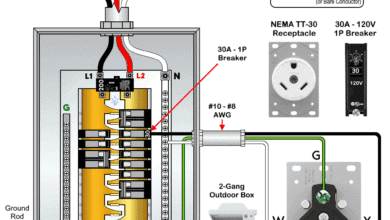Part 8 – Sizing Motor Feeder Protection and OCPD’s Devices
How to Determine the Size of Feeder Protection Supplying Several Motors?
In the previous section, we discussed sizing feeder conductors for multiple motors. This section will explain the step-by-step process for selecting protective devices, such as fuses and circuit breakers, for a feeder supplying multiple motors. Remember, general feeder circuits and motor feeders serve different purposes and follow different calculation methods.
Sizing Feeder Protection Supplying Multiple Motors
Feeder protection safeguards feeder conductors from overcurrent due to short circuits and ground faults. Branch circuit protection protects branch circuit conductors from the same hazards. Overload protection, installed near the motor, protects the motor circuit itself. For more details, refer to Figure 430.1 in the NEC to understand the different parts of a motor circuit with associated protection.
A feeder must be protected using a protective device. The device’s rating must not exceed the largest rating of the branch-circuit short-circuit and ground-fault protective device. Additionally, when determining the protective device rating, the sum of the full-load currents (FLC) of other motors connected to the same phase must be included (430.62(A)).
Feeder conductors for motors are sized based on NEC 430.24. The maximum allowable rating for a specific protective device is determined by 430.52 or 440.22(A).
When a feeder supplies two or more branch circuits where the same branch-circuit short-circuit and ground-fault protective device rating is used, one of these devices is considered the largest for calculation purposes. However, an exception applies under 340.90, where a single protective device provides both overcurrent and overload protection for the motor control circuit.
Good to Know:
- Motor feeder conductors are protected against overcurrent caused by short circuits and ground faults.
- The feeder protective device does not protect against motor overload. A separate overload protective device is required for overload protection.
According to 430.63, when a feeder supplies both motor loads and other load circuits, the rating of the feeder’s protective device must not be less than the sum of the other loads plus the following:
- The rating permitted by 430.52 for a single motor.
- The rating permitted by 440.22 for a single hermetic refrigerant motor-compressor.
- The rating permitted by 430.62 for two or more motors.
Example 1 – Sizing Feeder Protection Supplying Multiple Motors
Determine the required size of inverse-time breaker as a feeder protection device. The feeder supplying the following two single phase motors operated at 230V.
- 1.5 HP
- 2 HP
Solution:
1: Determine FLC of Each Motor
The full load current (FLC) of single phase motors are determined using Table 430.248. The FLC of 1-phase motors at 230V supply:
- FLC of 1.5 HP Motor = 10A
- FLC of 2 HP Motor = 12A
2: Size the the Branch Circuits (Optional Step)
Sizing of branch circuit for motor is determined using Tables 430.147 through 430.150 based on FLC and Table 310.16. for conductor sizing.
- 10A × 125% = 12.5 …… (for 1.5 HP Motor)
- 12A × 125% = 15A …… (for 2 HP Motor)
Referencing to the Table 310.16, the wire size at 60°C for both branch circuits supplying 1.5 HP and 2 HP motors is #14AWG Cu. or #12AWG Al.
3: Determine the Branch Circuit Protection
The branch circuit protection for both motors are sized in accordance with 430.52(C)(1), Table 430.52, & 240.6(A) as follow:
- 10A × 2.5 = 25A …… (for 1.5 HP Motor)
- 12A × 2.5 = 30A …… (for 2 HP Motor)
4: Size the Feeder Conductors (Optional Step)
The ampacity of feeder circuit supplying multiple motors can be calculated in accordance with 430.24(A). Since the largest motor is 30A based on FLC;
30A × 1.25 = 37.5A.
Now, sum app with the FLC of other motor(s).
37.5A + 10A = 47.5A.
The size of feeder conductor is determined using Table 310.16. For 47.5A, the size of feeder conductor is #8AWG cupper or aluminum (THHN) at 75°C.
5: Determine the Size of Feeder Protection
As stated above, the rating or setting of protective device should be less than the size of the branch circuit protection used for the largest motor (30A) plus the FLA of other motor(s) (25A). (430.62).
Hence (continue from step 2);
30A + 25A = 45A.
Since, the size of protection device for feeder conductors should be less than the above calculated value, the next down available size of standard breaker is 40A.
Feeder Protection Breaker = 40A
You may notice that we have selected the next size down for overcurrent protection instead of the next size up. This is because the NEC requires that feeder conductor protection must not exceed the branch circuit protection rating. Motor feeder protection is different from motor overload protection:
When sizing a feeder protection supplying multiple motors, only the motors on the same phase should be considered for additions of FLCs. This is why our calculations include four motors instead of all seven. The same rule applies when sizing feeder conductors supplying multiple motors, as they must be protected against motor overload and overcurrent caused by short circuits, and ground faults (Discussed in the previous part).
Series Overview: Motor Circuit Calculations
- Part 1 – Motor Load Circuits: NEC Terms and Basic Terminologies
- Part 2 – NEC Requirements for Motor Circuits
- Part 3 – Understanding NEMA Motor Nameplate Data
- Part 4 – Calculating Locked Rotor Current (LRC) for Motors
- Part 5 – Sizing Motor Branch Circuit Conductors
- Part 6 – Sizing Motor Feeder Conductors
- Part 7 – Sizing Motor Overcurrent Protection and OCPD’s Devices
- Part 8 – Sizing Motor Feeder Protection … (You are Here)
- Part 9 – Sizing Motor Overload Protection
- Part 10 – Overcurrent Protection for Motor Control Circuits
- Part 11 – Sizing Disconnecting Means for Motor & Controller
- Part 12 – Sizing Motor Starter & Contactor – NEMA – NEC
- Part 13 – Sizing Direct Online (DOL) Starters/Contactors for Motors (*Bonus)
- Part 14 – Sizing Star-Delta Motor Starters/Contactors for Motors (*Bonus)
Resources & Tutorials:
- Cable Size Calculation for LT & HT Motors
- Three Phase Motor Power & Control Wiring Diagrams
- What is Motor Efficiency & How to improve it?
- Star Delta 3-phase Motor Automatic starter with Timer
- How to Run a Three-Phase Induction Motor on a Single-Phase Power Supply?
- How to Wire ST01 Timer with Relay & Contactor for 120V/240V Motors?
- How to Wire Twin Timer in Repeat Cycle & One-Shot Mode for 120V/240V Motors?
- How to Control a Single-Phase Motor from Multiple Locations?
- Automatic & Manual Control of Motor Using VFD & DOL Starter
- How to Reverse and Forward a Three-Phase Motor Using a VFD?
- How to Wire a VFD with Motor, PLC, Switches & External Devices
- Sequential Motor Control Circuit Using LOGO! V8 PLC
- Automatic Reverse Forward Motor Control Circuit Using Delta – DVP-14SS PLC
- Reverse Forward Motor Control Circuit Using PLC – ZEN Programming Relay
- Motor Protection – Types of Faults and Protection Devices
- Cables Feeder Protection – Faults Types, Causes & Differential Protection
Wire Sizing Guides
- How to Find the Proper Size of Wire & Cable In Metric & Imperial Systems
- How to Size a Branch Circuit Conductors with Protection?
- How to Size Feeder Conductors with Overcurrent Protection
- How to Size Service-Entrance Conductors and Feeder Cables?
- How to Size Equipment Grounding Conductor (EGC)?
- How to Size Grounding Electrode Conductor (GEC)?
- What is the Right Wire Size for 15A Breaker and Outlet?
- What is the Suitable Wire Size for 20A Breaker and Outlet?
- How Size a Circuit Breaker for Different Load Applications







